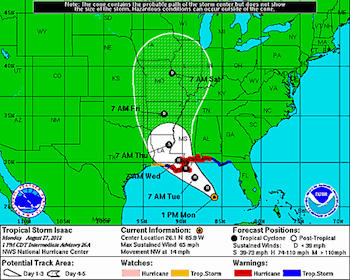Where the forecasts have barely improved in the last ten years or so is in their predictions of intensity. Will Isaac continue to progress as a tropical storm, as it has in recent days, or jump up the hurricane intensity charts? Today, forecasters are speculating that it might grow to a Category 2 storm, but nobody really knows for sure. And take last year’s Irene, widely feared to be an extremely powerful storm: it made landfall as a Category 1 (though its rains still did considerable damage). Whether a coming storm is going to be a Category 1, 2, 5, or a hurricane at all obviously matters a great deal to those in its path.
A few weeks ago, a little robot name Alex was launched from the coast of Puerto Rico as part of an effort to improve forecasters' ability to predict hurricane magnitude. Alex, a Wave Glider robot funded by its maker, Liquid Robotics, and operated under the guidance of the U.S. National Oceanographic and Atmospheric Administration (NOAA), is measuring ocean temperatures. Understanding water temperature is key to determining whether a hurricane will gather strength or fall apart, but the surface temperature data gathered by today’s satellites and airplanes is of limited use. Because storm winds and waves churn down below the surface, what’s going on a few meters down has as much impact on a developing storm than what’s just on the surface. Wave Glider Alex will be
Along with the temperature sensors, Alex carries a weather station that gathers wind, barometric pressure, and other standard measurements, plus a wave sensor that tracks direction, height, and other wave features. Alex is currently roaming the ocean north of Puerto Rico. Though it was not directly in the path of Hurricane Isaac, it did weather high winds and waves on Isaac’s fringes. As the Atlantic hurricane season progresses, it’s likely that Alex will find itself in a hurricane at some point this autumn.
While the data gathered by Alex won’t be used in operational forecasts—that is, the NOAA forecasts used to determine hurricane watches and warnings—it will be tested. Hurricane models will be run with and without data from Alex to see what, if any, improvement the new data offers, explains Ed Lu, chief of innovative applications for Liquid Robotics. “If this works as well as we think it might,” Lu says, “that’ll be a strong case for putting a lot of these systems out in the oceans.”
Follow me on Twitter @Tekla Perry.
Photo top: Hurricane Isaac’s path. Credit: National Hurricane Center
Photo center: Wave Glider Alex in the ocean near Puerto Rico. Credit: Liquid Robotics
Tekla S. Perry is a senior editor at IEEE Spectrum. Based in Palo Alto, Calif., she's been covering the people, companies, and technology that make Silicon Valley a special place for more than 40 years. An IEEE member, she holds a bachelor's degree in journalism from Michigan State University.





